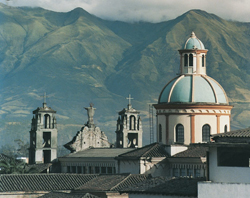Ecuadorembassy.org
About the Ecuador
Ecuador, officially the Republic of Ecuador (Spanish: República del Ecuador) is a representative democratic republic in South America, bordered by Colombia on the north, Peru on the east and south, and by the Pacific Ocean to the west. It is one of only two countries in South America, along with Chile, that do not have a border with Brazil. The country also includes the Galápagos Islands in the Pacific, about 1,000 kilometers (620 mi) west of the mainland.
 Ecuador straddles the equator, from which it takes its name, and has an area of 256,370 square kilometers (98,990 sq mi). Its capital city is Quito, which was declared a World Heritage Site by UNESCO in the 1970s for having the best preserved and least altered historic center in Latin America. The country's largest city is Guayaquil. The historic center of Cuenca, the third largest city in the country, was also declared a World Heritage Site in 1999, for being an outstanding example of a planned inland Spanish style colonial city in the Americas. Ecuador is also home—despite its size—to a great variety of species, many of them endemic, like those of the Galápagos islands. This species diversity makes Ecuador one of the seventeen megadiverse countries in the world. The new constitution of 2008 is the first in the world to recognize legally enforceable Rights of Nature, or ecosystem rights.
Ecuador straddles the equator, from which it takes its name, and has an area of 256,370 square kilometers (98,990 sq mi). Its capital city is Quito, which was declared a World Heritage Site by UNESCO in the 1970s for having the best preserved and least altered historic center in Latin America. The country's largest city is Guayaquil. The historic center of Cuenca, the third largest city in the country, was also declared a World Heritage Site in 1999, for being an outstanding example of a planned inland Spanish style colonial city in the Americas. Ecuador is also home—despite its size—to a great variety of species, many of them endemic, like those of the Galápagos islands. This species diversity makes Ecuador one of the seventeen megadiverse countries in the world. The new constitution of 2008 is the first in the world to recognize legally enforceable Rights of Nature, or ecosystem rights.
Ecuador is a presidential republic and became independent in 1830, after having been part of the Spanish colonial empire and the republic of Gran Colombia. It is a medium-income country with an HDI score of 0.807 (2007), and about 38.3% of the people living below the poverty line.
Geography
Ecuador has three main geographic regions, plus an insular region in the Pacific Ocean:
* La Costa, or the coast, comprises the low-lying land in the western part of the country, including the Pacific coastline.
* La Sierra ("the highlands") is the high-altitude belt running north-south along the center of the country, its mountainous terrain dominated by the Andes mountain range.
* La Amazonía, also known as El Oriente ("the east"), comprises the Amazon rainforest areas in the eastern part of the country, accounting for just under half of the country's total surface area, though populated by less than 5% of the population.
* The Región Insular is the region comprising the Galápagos Islands, some 1,000 kilometers (620 mi) west of the mainland in the Pacific Ocean.
Ecuador's capital is Quito, which is in the province of Pichincha in the Sierra region. Its largest city is Guayaquil, in the Guayas Province. Cotopaxi, which is just south of Quito, features one of the world's highest active volcanoes. The top of Mount Chimborazo (6,310-m above sea level) is considered to be the most distant point from the center of the earth, given the ovoidal shape of the planet (wider at the equator).
Climate
Although the country is not particularly large, there is great variety in the climate, largely determined by altitude. The Pacific coastal area has a tropical climate, with a severe rainy season. The climate in the Andean highlands is temperate and relatively dry; and the Amazon basin on the eastern side of the mountains shares the climate of other rain forest zones.
Because of its location at the equator, Ecuador experiences little variation in daylight hours during the course of a year.
Keep in Touch
Contact Us
Address: 1050 17th, St.
Suite 600 N.W.
Washington, DC 20036
Tel: 202 347-5800
202 347-5800
info@ecuadorembassy.org
